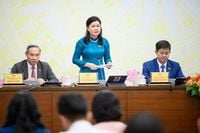On May 4, 2025, a significant press conference was held at the National Assembly House in Hanoi, where key discussions focused on the expected program for the 9th session of the 15th National Assembly. Nguyen Phuong Thuy, the Deputy Chairwoman of the National Assembly's Legal and Judicial Committee, provided insights into the appointment of personnel in reorganized administrative units, a topic that has been thoroughly researched and debated.
During the conference, Thuy elaborated on Conclusion 150 from the Politburo, which outlines a new mechanism for appointing officials to positions within the People's Councils and People's Committees of reorganized units, replacing the traditional election process. This change aims to streamline governance and enhance administrative efficiency, especially following the merging of various localities.
The National Assembly Standing Committee has requested the Government to propose a plan that institutionalizes the regulation of appointing, rather than electing, chairpersons and vice-chairpersons of the People's Councils and People's Committees in provinces after the merging of communes and wards. This proposal is rooted in the Politburo's directive from April 14, 2025, which emphasizes the need for effective management of personnel in newly formed administrative units.
Thuy noted that this appointment mechanism will only be implemented in 2025. After this period, the traditional electoral process for selecting officials within the People's Councils and People's Committees will resume. This temporary measure is designed to address immediate staffing needs while ensuring that the newly merged units can function effectively.
In addition to personnel appointments, the press conference also addressed the potential shortening of the term for the 15th National Assembly and all levels of People's Councils for the 2021-2026 term. This initiative aims to align the electoral schedule more closely with the conclusion of the National Congress of the Communist Party, which typically occurs in January. By shortening the term by approximately three months, the government hopes to facilitate a smoother transition and ensure that high-level appointments are made promptly.
Thuy explained that the current four-month period between the conclusion of the Party Congress and the elections is lengthy and can hinder effective governance. She stated, "The need to streamline the organizational structure and ensure timely appointments is crucial for the functioning of the state machinery. This adjustment will allow for a more efficient electoral process and quicker resolution of key personnel matters."
Moreover, the election law is undergoing amendments aimed at simplifying the electoral process and reducing implementation time, ensuring that citizens' rights to vote and run for office are upheld while making the process more efficient.
Meanwhile, in Lam Dong province, a parallel initiative is underway regarding the rearrangement of administrative units and the selection of new names for wards and communes following recent mergers. The local government has actively sought public opinion on these changes through ballots, indicating a strong commitment to ensuring that the new administrative structure aligns with the wishes of the residents.
According to reports, 97.86% of voters in Lam Dong agreed to merge Dak Nong, Binh Thuan, and Lam Dong provinces into a new province named Lam Dong, with Da Lat as its Administrative-Political Center. Additionally, 97.32% of voters supported the project for rearranging administrative units at the commune level, demonstrating overwhelming public support for these initiatives.
The rearrangement in Lam Dong has resulted in 51 administrative units at the commune level, comprising 9 wards and 42 communes. This process has significantly reduced the number of administrative units, achieving a reduction rate of 62.77%. The names selected for the new wards have been carefully chosen to reflect local history and culture, ensuring that they resonate with the community.
For instance, in Da Lat, the city has reduced its administrative units from 12 wards and 4 communes to 5 wards, achieving a reduction of 13 levels of communes. The newly named wards—Xuan Huong, Cam Ly, Lam Vien, Xuan Truong, and Lang Biang—are all tied to the city's unique geographical features and cultural heritage.
The selection process for these new names involved extensive consultation with local residents, resulting in a high level of agreement and satisfaction among the populace. This approach not only honors the historical significance of the names but also fosters a sense of belonging and identity among the residents.
However, not all changes have been met with unanimous approval. Some new names have been criticized for lacking historical context, as they incorporate numerical designations instead of traditional names. Critics argue that this approach undermines the cultural significance of the original names and the historical narratives they represent.
Thang, a local resident, expressed concern, stating, "While I understand the need for efficiency, we must not forget our roots. Names carry stories and memories; they are part of who we are. It would be a shame to lose that connection."
In Can Tho City, similar efforts are underway to rearrange administrative units at the commune level. Project No. 11/DA-UBND, issued on April 25, 2025, outlines plans for arranging and assigning civil servants and public employees while managing public offices during this transition. The project aims to maintain the current workforce while ensuring that the new administrative structure is effective and responsive to the needs of the community.
Each commune-level administrative unit will have designated leadership roles, including a Chairman of the People's Council and a Chairman of the People's Committee, to ensure smooth governance. Additionally, the project proposes to transfer all existing district-level staff to the new commune-level units, thereby retaining experienced personnel during this restructuring.
The initiative also addresses the future of non-specialized personnel at the commune level, with plans to phase out these positions by August 1, 2025. This change aims to streamline operations and enhance the efficiency of local governance.
As these administrative changes unfold, the emphasis on public involvement and feedback remains paramount. Local governments are keen to ensure that the voices of the residents are heard and integrated into the decision-making process. This participatory approach not only strengthens community ties but also fosters a sense of ownership among citizens regarding their local governance.
In summary, the ongoing restructuring of administrative units across Vietnam, particularly in Hanoi, Lam Dong, and Can Tho, reflects a broader commitment to enhancing governance, efficiency, and public engagement. As these changes take shape, the focus remains on aligning administrative practices with the needs and aspirations of the people, ensuring that the future of local governance is both effective and representative.





